![]()
Pollinator Paradise
Parma R & E Center
PSES
College of Agriculture
University of Idaho
Research slide shows
Bee management
Philosophy
Links
Contact us
![]()
|
Gary Marostica
|
and
|
Karen Strickler
|
| TABLE
OF CONTENTS
Results Figures |
As the availability of chemical controls for alfalfa seed pests declines, some alfalfa seed growers in the Treasure Valley of Idaho are showing increasing interest in using biological control of alfalfa pests. A dozen or so growers in the Parma/Wilder area were planning to try a biocontrol program in 1995. We worked with them to write a Farmer/Rancher Research Grant from the Western Region Sustainable Agriculture Program to pay for monitoring some of their fields, and to help defray the cost of biocontrol releases. With our help the growers received a $5000 grant. Eight sets of fields, one biocontrol field and one similar conventional field were monitored weekly during June and July for lygus bug, aphid and predator populations. Five of the field pairs were managed by the same growers. The other three biocontrol fields were matched with a nearby conventional field managed by a different grower. The growers with biocontrol fields received shipments of lady beetles, lacewings, and predatory mites from BIOFAC Inc., Mathis, Texas during the summer. In addition to monitoring, we obtained spray records from the growers, and information from BIOFAC about when biocontrol insects were released in the fields. We also took samples of seed harvested from each of the fields before the seed was cleaned in order to compare the percentage of seed with lygus damage in biocontrol and conventional fields. All but one of the eight biocontrol fields received a clean-up or pre-bloom spray in May or June. While none of the biocontrol fields had aphid levels that were above the published threshold of 100 pea aphids per 180 degree sweep, all reached threshold or near-threshold populations of 4 lygus bugs per sweep and had to be sprayed. One grower held off until as late as Aug. 6 to put on a spray of Dibrom, but others had to spray to control lygus populations at least once in July. Unfortunately, lygus populations exceeded threshold levels rather suddenly (Fig. 1) and sometimes needed closer monitoring than our weekly samples were able to provide. Minute pirate bugs were the most abundant predator in these fields. Pirate bugs, however, prefer to eat thrips, and eat lygus eggs only when thrip populations are low. Thrips were present in these fields, although their populations were not monitored. Interestingly, pirate bugs reached relatively high populations in both biocontrol and conventional fields; in 4 of the 8 pairs of fields pirate bugs were more abundant in conventional than in biocontrol fields. (However, pirate bugs exceeded 1 per sweep in 3 biocontrol but no conventional fields.) Perhaps minute pirate bugs are less susceptible to insecticides than are other predators. Preliminary studies of pesticide susceptibility in predators suggested that pirate bugs are similar to lygus bugs in susceptibility to Capture, whereas big-eyed bugs and damsel bugs are considerably more susceptible than lygus bugs. Another interesting observation was that minute pirate bugs sometimes reached peak populations when lygus populations were at their peak (Figs. 2,3). In these cases it is not clear whether pirate bug increases were a response to lygus bug increases or to concurrent increases in thrip populations. Did introductions of ladybugs and lacewings have any impact on the biocontrol fields, even if sprays for lygus bugs were necessary? Despite introductions of lacewings, these predators were found in very low numbers throughout the season, and seemed to show little response to aphid numbers(Fig. 4b, 5b). However, ladybug populations tended to peak at the same time or soon after aphid populations peaked (Fig. 4, 5). In conventional fields ladybug adult populations peaked between 0.3 and 0.5 per sweep, whereas in biocontrol fields they peaked between 0.35 and 2.5 per sweep. In only one of the eight pairs of fields were ladybug populations higher in the conventional field than in the biocontrol field. Thus, ladybugs probably contributed to crashes in aphid populations in biocontrol fields. However, we canít know for sure whether the ladybugs in a given field were primarily from releases, or whether many moved in from nearby fields because of availability of food. The ladybugs had help in many biocontrol fields from wasp parasites and fungal diseases of aphids. There was a significant though slight reduction in the number of insecticide applications in biocontrol fields (Table 1). This amounted to less than one application out of an average of 4 in conventional fields. However, the number of different pesticides applied to biocontrol and conventional fields was not significantly different (Table 1). Fewer biocontrol fields than conventional fields were treated with pyrethroids (Capture, Warrior). More biocontrol fields than conventional fields were treated with MSR. Table 2 compares the numbers of biocontrol and conventional fields that were treated with various insecticides and miticides. Dibrom was used in all but one field (a biocontrol field). |
TABLE 1: Comparison between biocontrol and conventional fields in number of insecticide and miticide applications over the 1995 season, and in the number of different compounds applied.
|
Field pair |
# applications |
# compounds |
||||||||||||
|
biocontrol |
conventional |
difference |
biocontrol |
conventional |
difference |
|||||||||
|
1 |
4 |
4 |
0 |
3 |
3 |
0 |
||||||||
|
2 |
4 |
4 |
0 |
3 |
3 |
0 |
||||||||
|
3 |
3 |
3 |
0 |
3 |
3 |
0 |
||||||||
|
4 |
2 |
4 |
-2 |
3 |
3 |
0 |
||||||||
|
5 |
2 |
3 |
-1 |
4 |
3 |
1 |
||||||||
|
6 |
6 |
7 |
-1 |
4 |
6 |
-2 |
||||||||
|
7 |
4 |
4 |
0 |
5 |
4 |
1 |
||||||||
|
8 |
3 |
4 |
-1 |
2 |
4 |
-2 |
||||||||
|
average |
3.5 |
4.13 |
-0.625 |
3.38 |
3.63 |
-0.25 |
||||||||
|
s.d. |
1.31 |
1.25 |
0.74 |
0.92 |
1.06 |
1.16 |
||||||||
|
standard error |
0.26 |
0.41 |
||||||||||||
|
Paired comparison T |
-2.376 |
-0.6070 |
||||||||||||
|
Probability |
0.049 |
* |
0.563 |
|||||||||||
Insecticide Applications
Table of Contents
TABLE 2: Number of biocontrol and conventional fields
using
various insecticides and miticides.
|
|
Number of Fields using the Pesticides |
|
|
|
Pesticides |
Biocontrol |
Conventional |
|
|
|
|
|
|
|
Capture |
2 |
4 |
|
|
Comite |
1 |
2 |
|
|
Cygon |
3 |
4 |
|
|
Dibrom |
7 |
8 |
|
|
Malathion |
2 |
2 |
|
|
MSR |
3 |
1 |
|
|
Pirimor |
2 |
2 |
|
|
Supracide |
3 |
2 |
|
|
Warrior |
3 |
4 |
|
Insecticide Applications
Top of page
| TABLE OF CONTENTS
Results Figures
|
It is not surprising that growers in the program eventually had to spray for high lygus populations. Lady beetles and lacewings are aphid predators, and are much less likely to switch to more active lygus bug nymphs than are other predators sometimes seen in alfalfa seed fields. The rationale behind trying a biocontrol program involving aphid predators was the hope that if aphid populations were low and insecticides were avoided, big-eyed bugs and damsel bugs would switch from aphids to lygus and would control lygus populations. Unfortunately, predator populations were very low this year in the monitored fields. The highest populations of big-eyed bugs and damsel bugs were only 0.4 per sweep. Percentage lygus damage in harvested seed before cleaning ranged from 10 to 36%. Biocontrol fields averaged 22% lygus damage while conventional fields averaged 21% damage. This difference was not significant (GLM test in SAS, F=0.50, P=0.4928). Although this biocontrol program proved inadequate for lygus control in the monitored fields, it is encouraging that so many alfalfa seed growers were willing to play a pioneering role in trying it. The prospect for successful biological control in alfalfa seed fields depends on finding a reliable source of big-eyed bugs and/or damsel bugs, and lygus parasites that can be released into seed fields as readily as lacewings and ladybugs. |
![]()
Top of page Pollinator Paradise
Parma R & E Center
PSES College of Agriculture
University of Idaho
Research slide shows
Bee management
Philosophy
Links
Contact us
![]()
Revised August 20 2000.
Copyright © 2000, Karen Strickler. All rights reserved.
|
Fig. 1: Lygus bug populations increased suddenly above the threshold of 4 per sweep after July 8. |
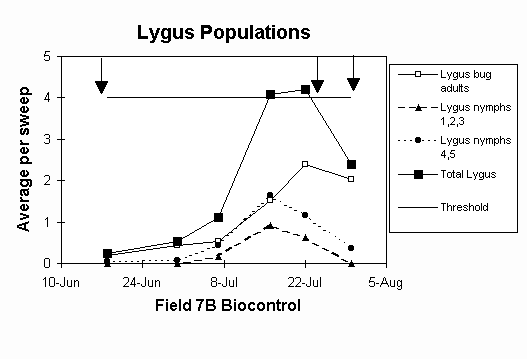
|
Figures 2., 3. Minute pirate bug populations increased concurrently with increases in lygus bug populations. Big-eyed bug and damsel bug populations were very low all season. Decreases in lygus bugs and their predators were due to insecticide sprays.
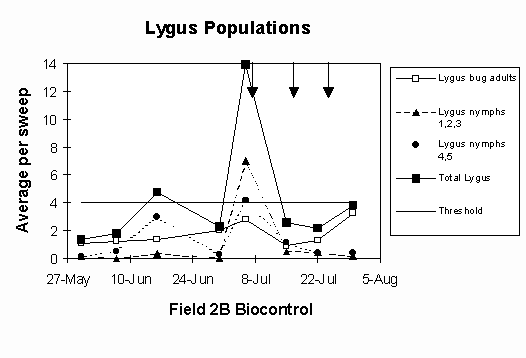 |
|
| Fig.2B | 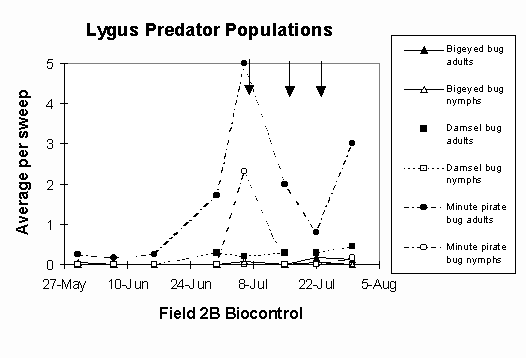 |
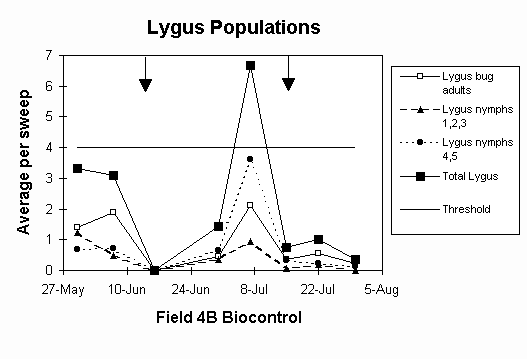
|
|
| Fig. 3B | 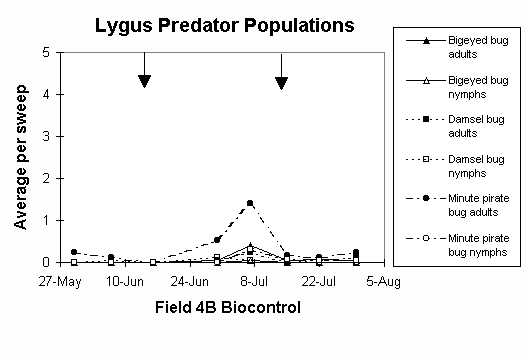
|
Fig. 4,5 Lacewing populations were low all season, but ladybugs tended to increase as aphids increased.
| Fig. 4A |
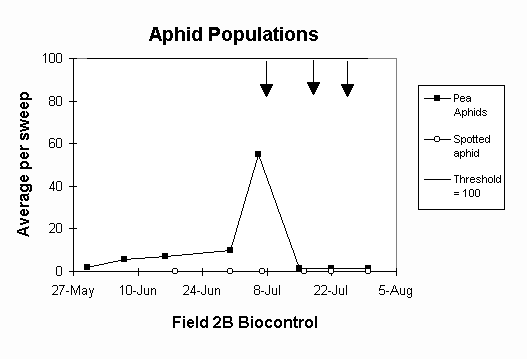 |
| Fig. 4B | 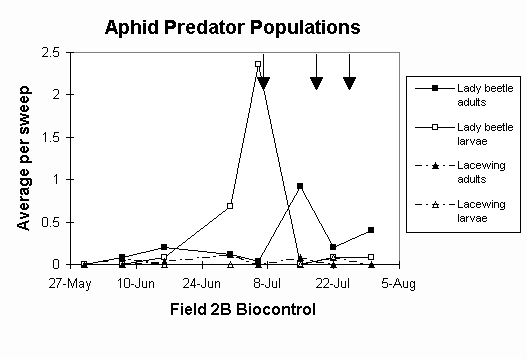 |
| Fig. 5A |
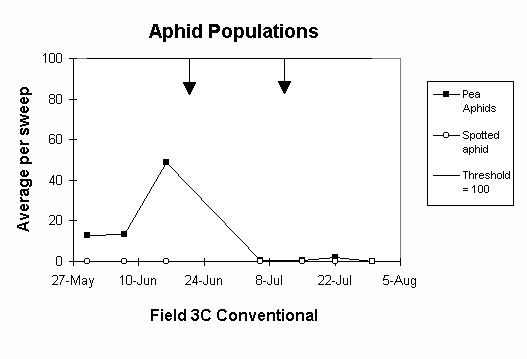
|
| Fig. 5B | 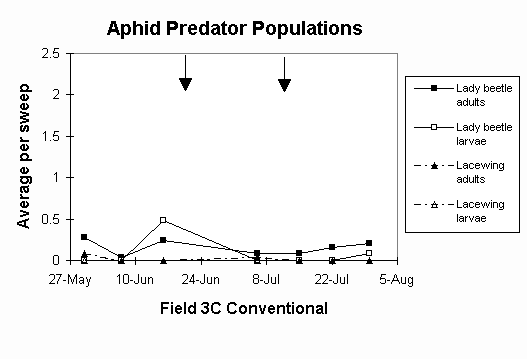
|
![]()
Top of page
Pollinator Paradise
Parma R & E Center
PSES
College of Agriculture
University of Idaho
Research slide shows
Bee management
Philosophy
Links
Contact us
![]()
Revised August 20, 2000.
Copyright © 2000, Karen Strickler. All rights reserved.